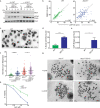ISG15 conjugation to proteins on nascent DNA mitigates DNA replication stress
- PMID: 36216822
- PMCID: PMC9550767
- DOI: 10.1038/s41467-022-33535-y
ISG15 conjugation to proteins on nascent DNA mitigates DNA replication stress
Abstract
The pathways involved in suppressing DNA replication stress and the associated DNA damage are critical to maintaining genome integrity. The Mre11 complex is unique among double strand break (DSB) repair proteins for its association with the DNA replication fork. Here we show that Mre11 complex inactivation causes DNA replication stress and changes in the abundance of proteins associated with nascent DNA. One of the most highly enriched proteins at the DNA replication fork upon Mre11 complex inactivation was the ubiquitin like protein ISG15. Mre11 complex deficiency and drug induced replication stress both led to the accumulation of cytoplasmic DNA and the subsequent activation of innate immune signaling via cGAS-STING-Tbk1. This led to ISG15 induction and protein ISGylation, including constituents of the replication fork. ISG15 plays a direct role in preventing replication stress. Deletion of ISG15 was associated with replication fork stalling, tonic ATR activation, genomic aberrations, and sensitivity to aphidicolin. These data reveal a previously unrecognized role for ISG15 in mitigating DNA replication stress and promoting genomic stability.
© 2022. The Author(s).
Conflict of interest statement
The authors declare no competing interests.
Figures






Similar articles
-
Restriction of Human Cytomegalovirus Replication by ISG15, a Host Effector Regulated by cGAS-STING Double-Stranded-DNA Sensing.J Virol. 2017 Apr 13;91(9):e02483-16. doi: 10.1128/JVI.02483-16. Print 2017 May 1. J Virol. 2017. PMID: 28202760 Free PMC article.
-
ISG15: A link between innate immune signaling, DNA replication, and genome stability.Bioessays. 2023 Jul;45(7):e2300042. doi: 10.1002/bies.202300042. Epub 2023 May 5. Bioessays. 2023. PMID: 37147792 Free PMC article. Review.
-
Deletion of BRCA2 exon 27 causes defects in response to both stalled and collapsed replication forks.Mutat Res. 2014 Aug-Sep;766-767:66-72. doi: 10.1016/j.mrfmmm.2014.06.003. Epub 2014 Jun 22. Mutat Res. 2014. PMID: 25847274
-
Deletion of BRCA2 exon 27 causes defects in response to both stalled and collapsed replication forks.Mutat Res. 2014 Aug-Sep;766-767:66-72. doi: 10.1016/j.mrfmmm.2014.06.003. Epub 2014 Jun 22. Mutat Res. 2014. PMID: 25773776 Free PMC article.
-
The interferon response at the intersection of genome integrity and innate immunity.DNA Repair (Amst). 2025 Jan;145:103786. doi: 10.1016/j.dnarep.2024.103786. Epub 2024 Nov 14. DNA Repair (Amst). 2025. PMID: 39577202 Review.
Cited by
-
cGAS-STING signalling in cancer: striking a balance with chromosomal instability.Biochem Soc Trans. 2023 Apr 26;51(2):539-555. doi: 10.1042/BST20220838. Biochem Soc Trans. 2023. PMID: 36876871 Free PMC article. Review.
-
African swine fever virus A151R downregulates cGAS-STING-mediated IFN-β production by promoting lipid peroxidation through ferritinophagy-induced ferroptosis.Cell Mol Life Sci. 2025 Jun 28;82(1):263. doi: 10.1007/s00018-025-05732-7. Cell Mol Life Sci. 2025. PMID: 40580330 Free PMC article.
-
When DNA-damage responses meet innate and adaptive immunity.Cell Mol Life Sci. 2024 Apr 17;81(1):185. doi: 10.1007/s00018-024-05214-2. Cell Mol Life Sci. 2024. PMID: 38630271 Free PMC article. Review.
-
Interferon restores replication fork stability and cell viability in BRCA-defective cells via ISG15.Nat Commun. 2023 Oct 2;14(1):6140. doi: 10.1038/s41467-023-41801-w. Nat Commun. 2023. PMID: 37783689 Free PMC article.
-
Unveiling the Multifaceted Roles of ISG15: From Immunomodulation to Therapeutic Frontiers.Vaccines (Basel). 2024 Feb 1;12(2):153. doi: 10.3390/vaccines12020153. Vaccines (Basel). 2024. PMID: 38400136 Free PMC article. Review.
References
-
- Cerami E, et al. The cBio cancer genomics portal: an open platform for exploring multidimensional cancer genomics data. Cancer Disco. 2012;2:401–404. doi: 10.1158/2159-8290.CD-12-0095. - DOI - PMC - PubMed
Publication types
MeSH terms
Substances
Grants and funding
LinkOut - more resources
Full Text Sources
Research Materials
Miscellaneous

